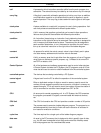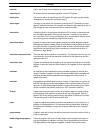201
Glossary
address The location in memory where data is stored. For data areas, an address
consists of a two-letter data area designation and a number that designate
the word and/or bit location. For the UM area, an address designates the in-
struction location (UM area); for the FM area, the block location (FM area),
etc.
allocation The process by which the PC assigns certain bits or words in memory for
various functions. This includes pairing I/O bits to I/O points on Units.
Analog Timer Unit A dedicated timer that interfaces through analog signal externally and digital
signals internally.
AND A logic operation whereby the result is true if and only if both premises are
true. In ladder-diagram programming the premises are usually ON/OFF
states of bits or the logical combination of such states called execution condi-
tions.
BCD Short for binary-coded decimal.
BCD calculation An arithmetic calculation that uses numbers expressed in binary-coded deci-
mal.
binary A number system where all numbers are expressed to the base 2. Although
in a PC all data is ultimately stored in binary form, binary is used to refer to
data that is numerically equivalent to the binary value. It is not used to refer
to binary-coded decimal. Each four binary bits is equivalent to one hexadeci-
mal digit.
binary-coded decimal A system used to represent numbers so that each four binary bits is numeri-
cally equivalent to one decimal digit.
bit The smallest unit of storage in a PC. The status of a bit is either ON or OFF.
Four bits equal one digit; sixteen bits, one word. Different bits are allocated to
special purposes, such as holding the status input from external devices,
while other bits are available for general use in programming.
bit address The location in memory where a bit of data is stored. A bit address must
specify (sometimes by default) the data area and word that is being ad-
dressed as well as the number of the bit.
bit designator An operand that is used to designate the bit or bits of a word to be used by
an instruction.
bit number A number that indicates the location of a bit within a word. Bit 00 is the right-
most (least significant) bit; bit 15 is the leftmost (most significant) bit.
buffer A temporary storage space for data in a computerized device.
bus bar The line leading down the left and sometimes right side of a ladder diagram.
Instruction execution follows down the bus bar, which is the starting point for
all instruction lines.


















